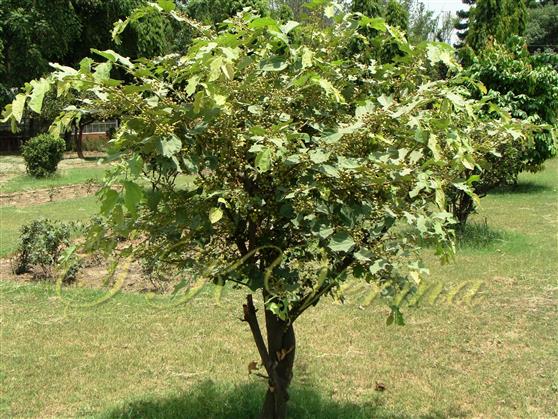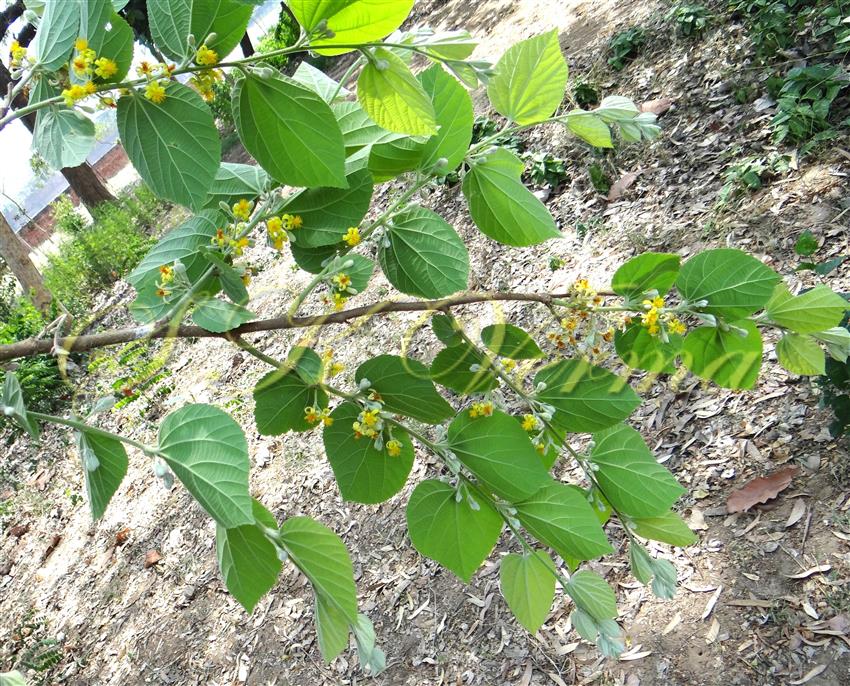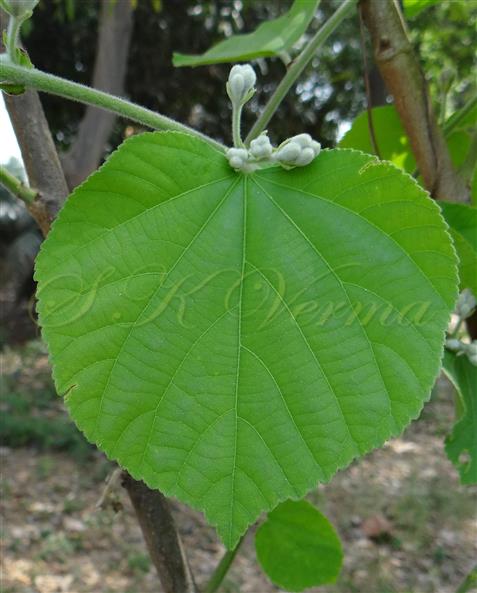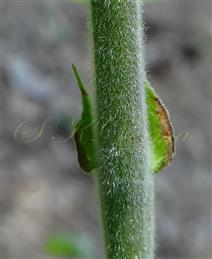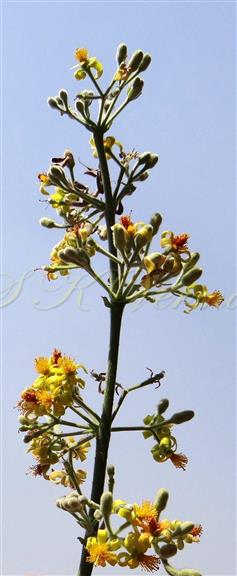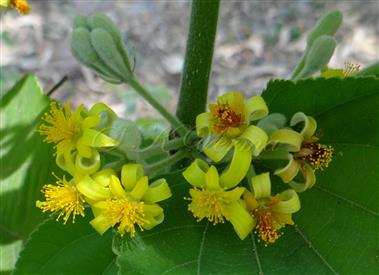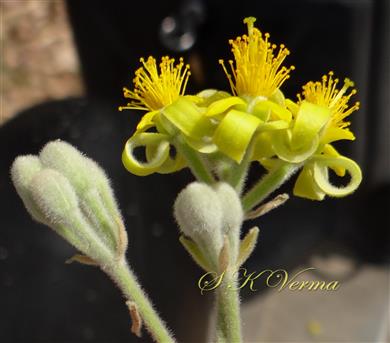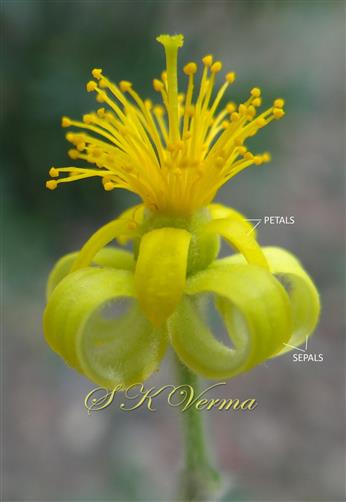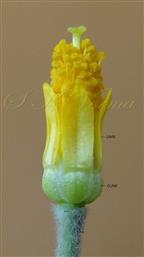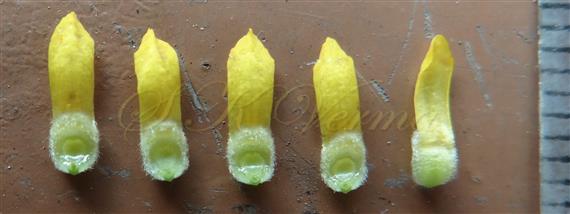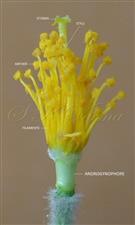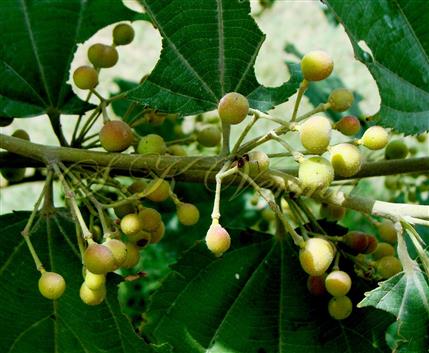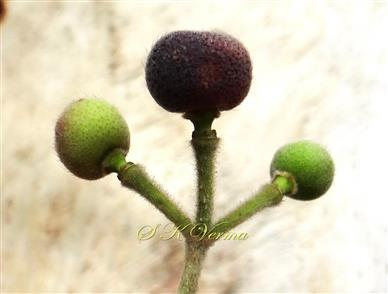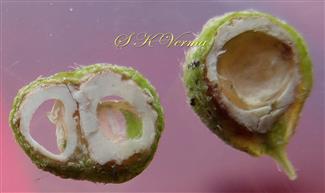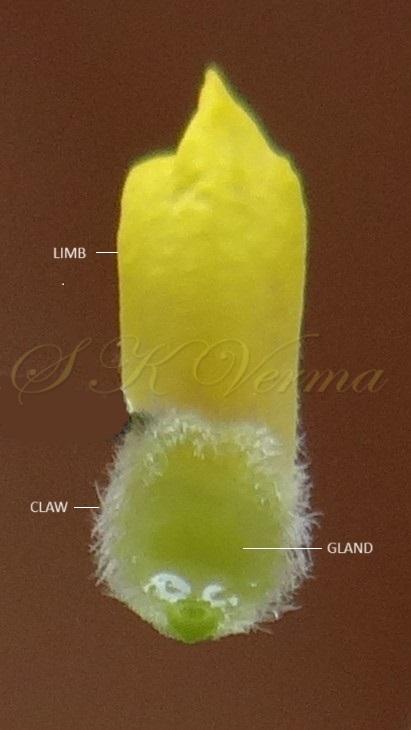GREWIA
Grewia
L., Sp. Pl. 964. 1753; Gen. Pl. 5: 412. 1754; DC., Prodr. 1: 508. 1824; Benth. & Hook. f., Gen. Pl. 1: 233. 1862; Boiss., Fl. Or. 1: 843. 1867; Masters in Hook. f., Fl. Brit. Ind. 1: 383. 1875; Narayanswami & Rao, J. Ind. Bot. Soc. 29(4): 177-190. 1950; Hutch., Gen. Fl. Pl. 1.2: 487. 1967; Parker, For. Fl. Punj. ed. 1: 49. 1918 (Reprint 1973); Fl. China @ eFloras.org 12: 251; Fl. Pak. @ eFloras.org p. 2.
Deciduous shrubs or trees, occasionally scrambling; twigs, leaves, peduncle and sepals usually clothed with stellate hairs. Leaves simple, alternate, distichous, stipulate, petiolate, more or less distinctly toothed, rarely lobed, 3-7-nerved, somewhat coriaceous. Flowers usually bracteate, actinomorphic, bisexual, pentamerous, hypogynous, yellow or orange in pedunculate cymes or umbels, peduncles solitary or fascicled, axillary or leaf-opposed. Sepals 5, free, leathery, valvate, often coloured on the inside, deciduous. Petals 5, free, rarely wanting, mostly shorter than sepals, clawed, claw thick, pitted or glandular near the point of insertion surrounded by a villous rim. Stamens usually indefinite, inserted on the androgynophore; androgynophore short, usually glabrous; filaments of irregular length; anthers globose, dorsifixed; dehiscence longitudinal. Carpels 2-4, syncarpous, ovary superior on top of androgynophore, ovary 2-4-locular, ovules usually 8 (each with 2 or more superposed ovules); style one, subulate with 2-4-lobed stigma or laciniate, sometimes peltate, entire. Fruit a drupe, often lobed, containing 1-4 druplets (or pyrenes) which are 1-2- many seeded, often transversely septate between seeds; endocarp usually bony, mesocarp fibrous. Seeds suberect or horizontal, endospermous, embryo straight.
321 species
Grewia asiatica
Grewia asiatica
L., Mant. Pl. 1: 122. 1767; DC., in Prodr. 1: 511. 1824; Boiss., Fl. Or. 1: 844. 1867; Masters in Hook. f., Fl. Brit. Ind. 1: 386. 1875; Stewart & Brandis, For. Fl. 40. 1874; Watt., Diet. Econ. Prod. Ind. 4: 184. 1890; Talbot, For. Fl. Bomb. Pres. and Sind, 1: 162. 1911; Bamber, Fl. Punj. Pl. 9. 1916; Cooke, Fl. Pres. Bomb. 1: 150. 1958 (Reprinted ed.); Maheshwari, Fl. Delhi 87. 1963; Jafri, Fl. Kar. 212. 1966; Fl. Pak. @ eFloras.org p. 14; BSI- eFlora of India vol. 3; G.subinaequalis DC., Prodr. 1:511.1824; Parker, For. Fl. Punj. ed 1:52. 1918 (Reprint 1973); G.hainesiana Hole, Indian Forester 43:216. 1917.
A large shrub or medium-sized tree, up to 8 m tall. Stem with greyish-white to brown bark. Young shoots stellate tomentose. Leaves alternate, distichous, stipulate; petioles 1-2.8 cm long, clavate, stellate hairy; leaf blade greyish-tomentose beneath, scabrous above, broadly ovate to almost orbicular, 5-15 cm x 5-15 cm, 5-7-nerved, obliquely shallowly cordate at base, serrate, acute to obtuse. Stipules narrowly oblique-lanceolate to falcate, 1-1.3 cm long, stellate hairy on both sides. Cymes mostly 3-flowered (dichasial), 2-6(-10) together in axillary clusters, peduncles 1.5-3.5(-5) cm long, densely hairy. Flowers actinomorphic, bisexual, pentamerous, hypogynous, orange-yellow, ca. 2 cm across; pedicels 1-1.3(-1.5) cm long, densely hairy; bracts linear-lanceolate, 3-4 mm long. Sepals 5, free, 0.6-1.4 cm x 2.5-3(-5) mm, oblong, hairy outside, glabrous within, acute, deflexed. Petals 5, free, orange-yellow, oblong, clawed: claw ca. 2 mm long with a ring of hairs around whitish gland, gland ca. 1 mm x 0.7 mm; limb 4-5 mm x ca. 3 mm, irregularly lobed at the apex. Stamens numerous, inserted on short glabrous androgynophore; filaments 4-6 mm long, orange-yellow, turning purplish; anthers oblong, dorsifixed, bithecous, dehiscence longitudinal. Ovary ovoid, 1.5-2.5 mm x 1-1.5 mm, villous; style ca. 5 mm long; stigma indistinctly 4-lobed. Drupes 7-22 mm across, subglobose, obscurely 2-lobed, red or purple, pilose.
Common Names: Phalsa (Falsa)
